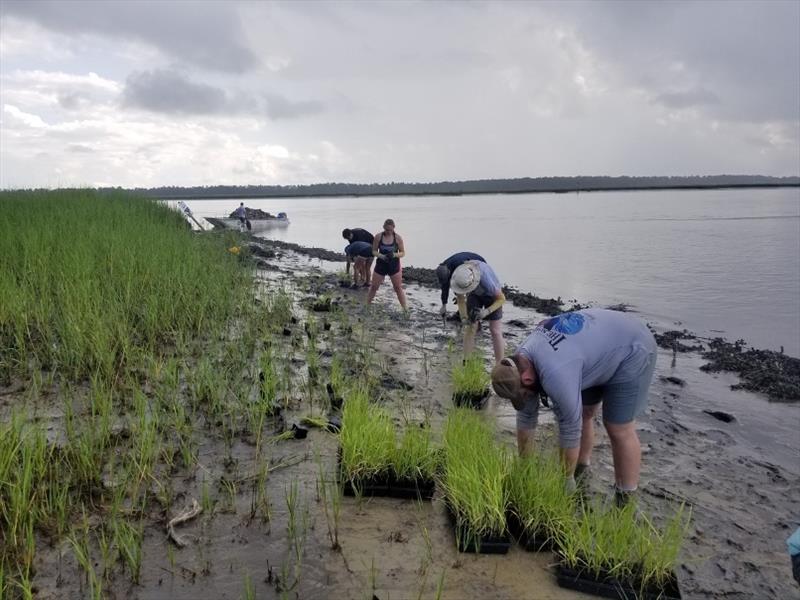
Progress on efforts to engage recreational anglers and restore habitat
by NOAA Fisheries 21 Jun 2020 14:27 UTC

Volunteers carrying and planting marsh grass in South Carolina © South Carolina Department of Natural Resources
In 2019, NOAA funded three projects to restore coastal habitat and enhance recreational fisheries engagement in North Carolina, South Carolina, and Alaska.
The projects were funded through the National Fish Habitat Partnership. They demonstrate our commitment to engage anglers in habitat restoration efforts, and support access to sustainable saltwater recreational fishing opportunities. One year later, we're checking in on how the projects are benefiting coastal habitats, communities, and economies.
Oyster reef and salt marsh restoration in South Carolina
The South Carolina Department of Natural Resources set out to work with anglers to restore and monitor oyster reefs and plant adjacent saltmarsh. To date, the project team has:
- Constructed three oyster reefs and planted salt marsh species at two sites.
- Hosted events where more than 920 volunteers worked to sort and bag oyster shells and plant marsh seed.
- Completed pre-restoration monitoring, and plans to continue monitoring efforts to inform adaptive management practices.
Ultimately, the project aims to provide habitat for several recreationally important species through the Southeast region. These include red and black drum, flounder, gag grouper, bluefish, blue crabs, oysters, and shrimp. This work is being conducted as part of the Southeast Aquatic Resources Partnership.
Oyster reef and salt marsh restoration in North Carolina
The North Carolina Coastal Federation worked with angler volunteers to restore oyster reef and salt marsh habitat in Stump Sound. The project also aimed to translate recreational fishing publications and regulations into Spanish to provide language access for the nearby community. To date, the project team and volunteers have:
- Conducted physical and aerial surveys to inform the design of the salt marsh and oyster habitat restoration.
- Monitored oyster spat at specific sites to better understand where oysters recruit—or grow their populations—along the coast.
- Collected recycled oyster shells and held volunteer events to sort and bag oyster shells.
- Identified outreach materials for reformatting and translation to Spanish.
As next steps in the project, the team and volunteers plan to:
- Host public volunteer events to construct oyster reefs and plant salt marsh habitat.
- Engage Spanish speaking anglers during Latino Conservation Week.
- Translate materials into Spanish and distribute them to the community.
Once completed, the restored salt marsh and oyster reef will provide habitat for red drum, sheepshead, spotted seatrout, weakfish, spot, Atlantic croaker, and shrimp. Outreach efforts will also better engage the local Spanish-speaking community. This work is being conducted through the
Atlantic Coastal Fish Habitat Partnership.
Habitat restoration efforts in Alaska
The Kenai Watershed Forum is developing a plan to expand the outreach and volunteer restoration efforts of its water stewardship program, Stream Watch, on Alaska's Kenai Peninsula. The project will engage local angling groups to assist land management agencies with peer-to-peer education and hands-on river restoration. These projects will protect and restore recreational fishing resources. The work will increase the program's capacity to partner with local fishing groups and leverage efforts to improve ecological concerns for fish and their habitats. This work is being conducted as part of the Kenai Peninsula Fish Habitat Partnership.
The projects were selected based on their active engagement of recreational fishing partners in habitat protection or restoration efforts, and the potential to build long-term relationships with those partners. This collaborative funding opportunity continued in 2020 with projects in Alaska, Washington, California, and Virginia.
The projects were funded by NOAA Fisheries through its Office of Habitat Conservation and Recreational Fisheries Initiative, in partnership with the Atlantic States Marine Fisheries Commission and Pacific States Marine Fisheries Commission.